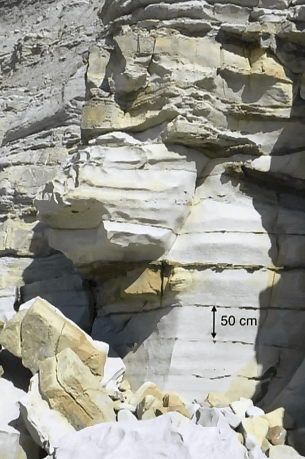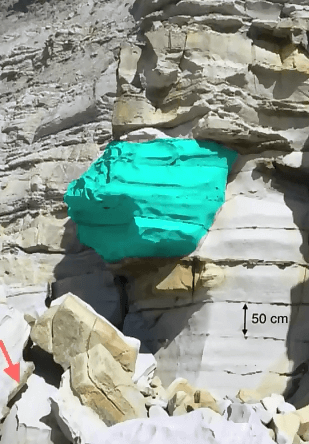 In this topic we will discuss what constitutes a rock mass and its relevance for engineering.in this photo, you can see a rock face and what is quite clear is that the rock is not homogeneous. Compare to this specimen of sandstone, which has a uniform color and no clear planes crossing it. In contrast, the photo shows many lines, vertical lines and horizontal lines. Vertical lines are simply referred to as discontinuities and discontinuities fall into two categories. They’re called faults if some relative movement has taken place. As we can see on this second photo, you can see that the stripes of color do not align from left to right. There’s been some vertical movements that offsets the stripes. This happens along the faults. If there is no relative movement observed, these are typically called joints.
In this topic we will discuss what constitutes a rock mass and its relevance for engineering.in this photo, you can see a rock face and what is quite clear is that the rock is not homogeneous. Compare to this specimen of sandstone, which has a uniform color and no clear planes crossing it. In contrast, the photo shows many lines, vertical lines and horizontal lines. Vertical lines are simply referred to as discontinuities and discontinuities fall into two categories. They’re called faults if some relative movement has taken place. As we can see on this second photo, you can see that the stripes of color do not align from left to right. There’s been some vertical movements that offsets the stripes. This happens along the faults. If there is no relative movement observed, these are typically called joints.
The rock mass, as a whole is a combination of blocks of homogeneous rock, also called rock matrix, or intact rock separated by discontinuities. The rock matrix has certain properties depending upon its mineralogy, origin, the degree of weathering, and the discontinuities would have different properties.

When it comes to strengths, the discontinuities are typically weaker than the intact rock and that’s very clear from this third photo here. When we see blocks at the top of the cliff, these blocks have detached from the rock mass and if we look carefully, we can see that they have detached along the discontinuity planes. That’s very clear from the blue block where we can see that vertical and horizontal planes are defining the block and if you look at the block at the top of the cliff with the red arrow pointing at it, you can see that this layer of the brown material appears on the rock face on one of the horizontal planes. This shows the discontinuities are the weak planes of the rock mass. Discontinuities are the weak point of the rock mass and overall, the strength of the rock mass is lower than that of the intact rock because of these discontinuities.
There is another characteristic of discontinuities that has to be pointed out. Can you see in this photo how the vegetation has grown on the rock? This is because there is water. Water flows along the path of least resistance and in rock mass, this is typically the discontinuities. Water tends to pose two issues in the rock mass. First, it’s determined of its stability. Second effect is that it could lead to unwanted water flow in the rock mass. For example, there are cases where there is flooding of underground openings because of the water flowing in rock joints.
So in conclusion, although testing on rock is typically conducted on an intact rock, when it comes to an engineering structure involving a rock mass, it is very important to account for the presence and effect of discontinuities.
Related: Best Rock Hammers
https://youtu.be/K_zprYdMoj8
